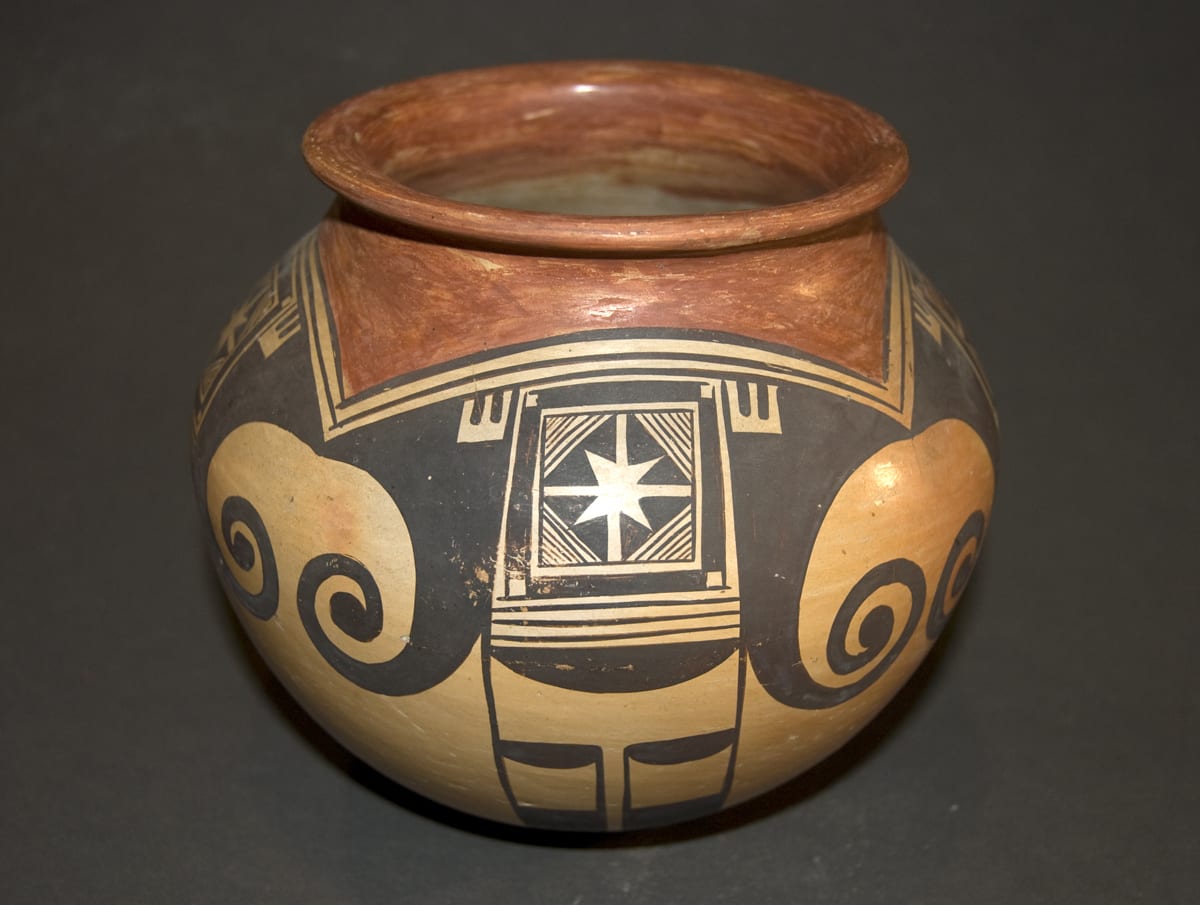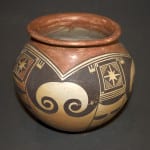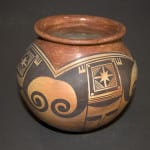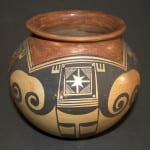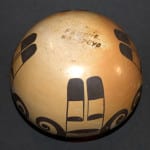The signature on 2009-01 is exactly the same as on 2001-07 and 2009-14 and is also the same as on 2007-12, except that the latter jar was formed by Nampeyo and painted by Fannie so the two words are reversed: “Nampeyo Fannie.” All four pots were probably made in the late 1930s to early 1950s.
It is instructive to compare 2007-12 with 2009-01 since both jars are approximately the same age and shape, and both were painted by Fannie with roughly the same design.
During the height of her career (1895-1915), Nampeyo’s extraordinary sense of design (and Fred Harvey Co. publicity) made her world famous. [See Fred Harvey Co.,1914.] In the early part of the century, the Harvey Co. even printed labels “Made by Nampeyo” to mark her pots and merchandise her work. Twenty years later, after she was functionally blind, the pots formed by Nampeyo, painted by Fannie, and signed “Nampeyo” on the bottom did not attempt to match Nampeyo’s earlier aesthetic. Like the earlier Harvey stickers, these pots seem made to take advantage of Nampeyo’s name in order to provide “the Old Lady” with some income. They sold because of the famous name on the bottom; tourists probably had little regard for the aesthetic of the painting and Fannie had little incentive to do her best work. Fannie’s considerable skill in design is better seen in pots made at the same time that carried her name and sought to establish an independent reputation in the Anglo tourist market.
This theory is supported by comparing 2001-07 and 2009-01 (both formed and painted by Fannie) to 2007-12 (formed by Nampeyo and painted by Fannie).
Admittedly, pot 2007-12 is smaller than 2009-01; there is room for a more elaborate design on the larger pot. Nevertheless, numerous smaller pots in the collection are carefully painted—often with quite elaborate designs. [For a small, elegant, Fannie pot, see 2009-14.]
The thick, heavy form of the eagle tails is almost identical on 2007-12 and 2009-01. Pot 2007-12 is monochromatic while 2009-01 has a red neck (and 2007-12 has no neck). The painting on 2007-12, however, is particularly heavy: the hanging design enclosed by the eagle “wings” is a static rectangle with three thick lines emerging. Except for two sets of two lines incorporated in the two “tail” panels, the elements forming the tail are bold, dark, and heavy. Nampeyo formed 2007-12 and Fannie painted it with a heavy hand.
In contrast, Fannie formed and painted 2009-01, and the painting is both more detailed and careful than 2007-12. Unlike 2007-12, each tail element on 2009-01 has an insert of two small parallel lines at its thickest point—a device developed by her mother that lightens the image. The hanging pathos form evident on 2007-12 is missing, which leaves a more open feel to the surface between the “wings” on 2009-01. On 2009-01, the linearity of the “tails” is broken up by open box design just below the neck and there is more open-space in the lower design of the tails, though the tips of the tails on the two pots seem identical. Similarly, seed jar 2001-07—formed and painted by Fannie—has an innovative and exceptionally well-painted “art deco” design. As pot 2001-07 represents her best work during the 1930s or early 1940s, seed pot 2009-14 represents her best work of the 1950s.
In short, the contrast between 2007-12 and 2009-01 reinforces our sense that, typically, pots that Fannie painted and Nampeyo formed while she was functionally blind seem to exhibit more casual and heavier designs than pots Fannie formed and painted (see 1997-01 and 2002-12). There are two exceptions to this pattern in the collection. A careful though not particularly inspired design decorates 1985-01, which Fannie painted and her mother made. The second contrary example is the pot Annie made and Fannie elegantly painted with an exquisite light and balanced design (2008-01). This pot was apparently custom ordered by an Anglo who lived at Hopi, and it was not sold as an “Old Lady” pot. In addition, in contrast to her mother, Annie in the 1930s did not yet have a loss of vision and could see the quality of her younger sister’s work.
[For a larger and somewhat more elaborate version of an eagle-tail pot by Fannie, see Arrowsmith,1981:30.] Also see the photograph of a Fannie eagle tail jar sold by Bonhams in September 2010, on file.

